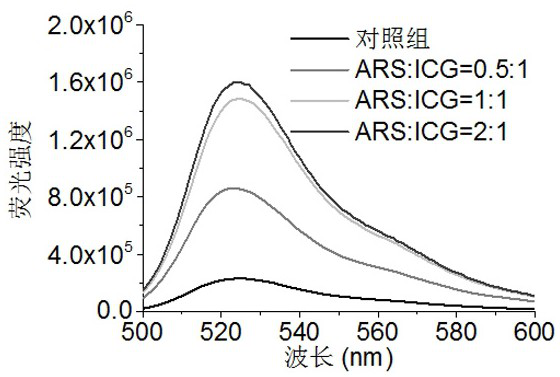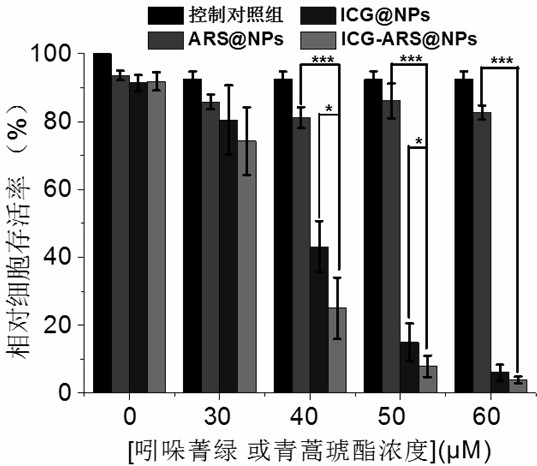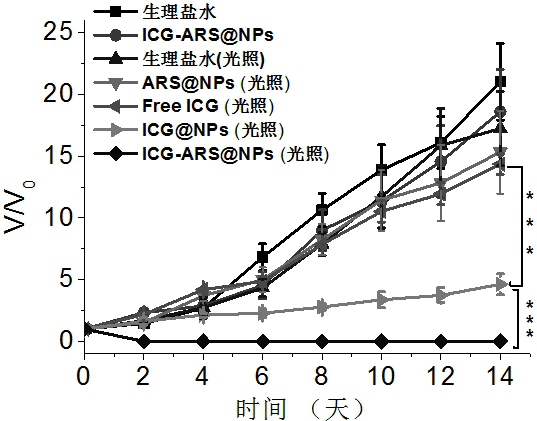Application of artemisinin and derivative thereof to preparation of sensitizer for thermodynamic therapy
A thermodynamic and derivative technology, applied in the field of functional materials and drugs, to achieve the effects of being beneficial to clinical use and promotion, high human safety, and ingenious overall design
- Summary
- Abstract
- Description
- Claims
- Application Information
AI Technical Summary
Problems solved by technology
Method used
Image
Examples
Embodiment 1
[0026] Example 1 Artemisinin derivatives as thermodynamic therapy sensitizers
[0027] 2',7'-dichlorofluorescein diacetate (abbreviated as DCFH-DA) hydrolysis product 2',7'-dichlorofluorescein diacetic acid (referred to as DCFH) is used as a probe for active oxygen, and the excitation wavelength of the probe is 488nm, the emission wavelength detection range is 500-600nm. The preparation of the hydrolyzed aqueous solution of DCFH-DA refers to existing papers (" J. Immunol. Methods》 1993, 159 (1-2), 131-138 carried out). By observing the fluorescence of DCFH (at around 524nm) in the solution containing the sample to be tested with the laser irradiation time, the ability of the sample to generate ROS thermally was determined. The stronger the fluorescence intensity generated by DCFH, the stronger the thermally sensitive ROS generation ability.
[0028] Taking artesunate (ARS) as an example for determination, the specific determination method is to weigh an appropriate amount...
Embodiment 2
[0031]Through literature research and experiments, it is found that when the concentration of indocyanine green reaches 100 μM, the aqueous solution in which it is located can be heated to 50 ° C, which can meet the requirements of artesunate to generate active oxygen by heating. The ratio of green found that the ratio of artesunate to indocyanine green will show different properties within a certain range, such as figure 1 As shown, artesunate: indocyanine green = 1:1 and artesunate: indocyanine green = 2:1 have the strongest ability to generate active oxygen and have the same intensity, so indocyanine green is selected as the drug for laser irradiation A heat source was generated, and artesunate: indocyanine green = 1:1 was used as the optimal drug ratio form.
Embodiment 3
[0032] Example 3 Liposome nano-drug loaded with indocyanine green and artesunate
[0033] Weigh dipalmitoylphosphatidylcholine, distearoylphosphatidylethanolamine-polyethylene glycol 2000, cholesterol hemisuccinate, artesunate and indole at a molar ratio of 12:1.5:9:3:13 Cyanine green, add chloroform (10 mL) and methanol (10 mL), dissolve it in the mixed solvent, and then sonicate for 5 min. Then the solution was dried by rotary evaporation, and further deionized (DI) water was used to form liposome suspension. The liposome suspension was then pulverized by an ultrasonic cell disruptor at 10°C for 10 minutes, and dialyzed against deionized water (membrane molecular weight cut-off 10,000) at 25°C for 48 hours to remove free indocyanine green and artemisia annua succinate to obtain ICG-ARS@NPs.
[0034] Electron microscope analysis showed that the obtained liposome nanocomplex was relatively uniform spherical or near-spherical vesicles with a particle diameter of about 150 nm....
PUM
| Property | Measurement | Unit |
|---|---|---|
| particle diameter | aaaaa | aaaaa |
| particle diameter | aaaaa | aaaaa |
Abstract
Description
Claims
Application Information
 Login to View More
Login to View More - R&D
- Intellectual Property
- Life Sciences
- Materials
- Tech Scout
- Unparalleled Data Quality
- Higher Quality Content
- 60% Fewer Hallucinations
Browse by: Latest US Patents, China's latest patents, Technical Efficacy Thesaurus, Application Domain, Technology Topic, Popular Technical Reports.
© 2025 PatSnap. All rights reserved.Legal|Privacy policy|Modern Slavery Act Transparency Statement|Sitemap|About US| Contact US: help@patsnap.com



